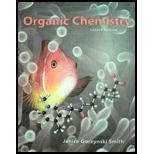
Concept explainers
(a)
Interpretation: A second resonance structure for the given species and the resonance hybrid is to be drawn.
Concept introduction: Resonance structure is a blend of two or more Lewis structures. Resonance structures are represented by a double headed arrow between the structures.
(b)
Interpretation: A second resonance structure for the given species and the resonance hybrid is to be drawn.
Concept introduction: Resonance structure is a blend of two or more Lewis structures. Resonance structures are represented by a double headed arrow between the structures.
(c)
Interpretation: A second resonance structure for the given species and the resonance hybrid is to be drawn.
Concept introduction: Resonance structure is a blend of two or more Lewis structures. Resonance structures are represented by a double headed arrow between the structures.
(c)
Interpretation: A second resonance structure for the given species and the resonance hybrid is to be drawn.
Concept introduction: Resonance structure is a blend of two or more Lewis structures. Resonance structures are represented by a double headed arrow between the structures.
Want to see the full answer?
Check out a sample textbook solution
Chapter 1 Solutions
Organic Chemistry - With Access (Custom)
- Need help drawing any other resonance structures of A.arrow_forwardFollow the curved arrows to draw a second resonance structure for eachspecies.arrow_forwarda. Which of the following has a greater electronegativity? (circle one) Carbon / Cesium b. Explain why you chose your answer in Za.arrow_forward
- Label the resonance structures in each pair as major, minor, or equal contributors to the hybrid. Then draw the hybridarrow_forwardCompound b is more polar than A. Explain. (Hint: draw resonance structures)arrow_forwardDraw a second resonance structure and the hybrid for each species, and then rank the two resonance structures and the hybrid in order of increasing stability.arrow_forward
- Draw all reasonable resonance structures for the following cation. Then draw the resonance hybrid.arrow_forwarddraw all possible lewis/resonance sturcures for CBr2O and circle/explain the best onearrow_forwardHelp! a.) Draw all the important resonance contributors for the structure shown below. Use curved arrows to show the movement of electrons between these contributors. b.) Draw the hybrid resonance hybrid structure.arrow_forward
 World of Chemistry, 3rd editionChemistryISBN:9781133109655Author:Steven S. Zumdahl, Susan L. Zumdahl, Donald J. DeCostePublisher:Brooks / Cole / Cengage Learning
World of Chemistry, 3rd editionChemistryISBN:9781133109655Author:Steven S. Zumdahl, Susan L. Zumdahl, Donald J. DeCostePublisher:Brooks / Cole / Cengage Learning
